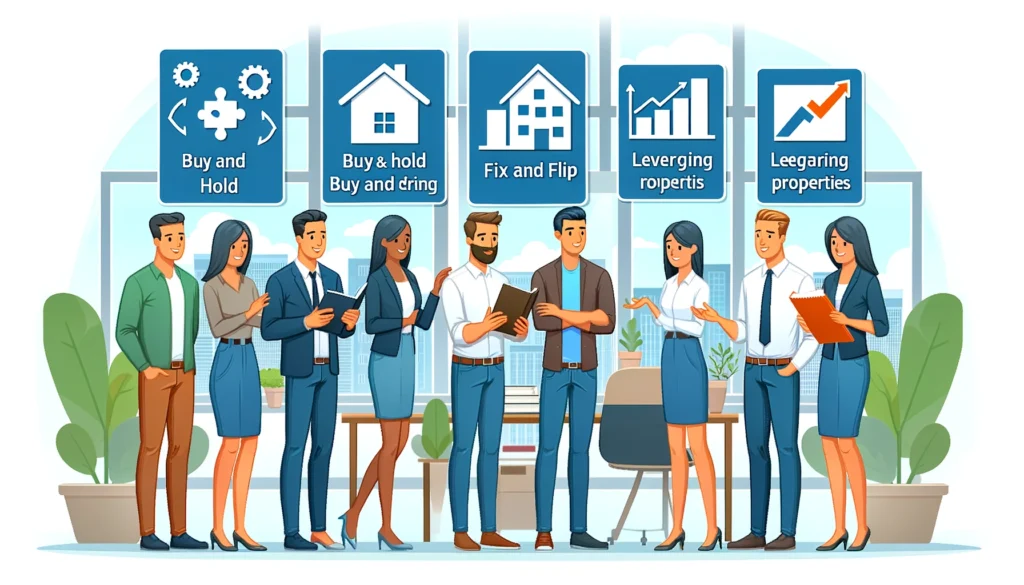Estudo de caso 4: Explorando diferentes estratégias de investimento imobiliário

Estudo de caso 4: Explorando diferentes estratégias de investimento imobiliário
Case Study Learning Objectives:
In this case study, students will follow David as he explores various real estate investment strategies, including buy and hold, fix and flip, and leveraging properties. This case study equips students with the knowledge to maximize returns through diverse investment strategies.
Case study overview:
Case Study Information:
David is a 40-year-old real estate investor interested in exploring different investment strategies to maximize his returns. He plans to analyze the steps involved, benefits, and risks of each strategy.
Hypothetical Scenario:
David is evaluating different real estate investment strategies, including buy and hold, fix and flip, and leveraging properties. He needs to understand the steps involved, benefits, and risks associated with each strategy to choose the right approach based on market conditions and personal goals.
Part 1: Buy and Hold Strategy
Information for Part 1:
The buy and hold strategy involves purchasing properties and holding them for an extended period to benefit from rental income and property appreciation.
- Steps Involved: Identify and purchase undervalued properties, manage rental properties, and hold for long-term appreciation.
- Benefits: Steady rental income, potential for significant property appreciation, and tax advantages.
- Risks: Market fluctuations, property management challenges, and potential for prolonged vacancies.
Questions for Part 1:
- What are the key steps involved in the buy and hold strategy for real estate investing?
- How can David mitigate the risks associated with the buy and hold strategy?
Part 2: Fix and Flip Strategy
Information for Part 2:
The fix and flip strategy involves purchasing properties, renovating them, and selling them for a profit within a short period.
- Steps Involved: Identify distressed properties, renovate to increase value, and sell quickly for a profit.
- Benefits: Potential for high returns in a short period, opportunity to add significant value through renovations.
- Risks: High upfront costs, potential for renovation delays, and market volatility affecting sale prices.
Questions for Part 2:
- What are the key steps involved in the fix and flip strategy for real estate investing?
- How can David manage the risks associated with the fix and flip strategy?
Part 3: Leveraging Properties
Information for Part 3:
Leveraging properties involves using borrowed capital to increase the potential return on investment.
Real-World Example:
Leveraging Properties:
- David purchases a rental property worth $300,000 with a $60,000 down payment and finances the remaining $240,000 with a mortgage.
- Rental Income: The property generates $2,500 per month in rental income.
- Mortgage Payments: Monthly mortgage payments total $1,200, leaving a net rental income of $1,300.
- Appreciation: Over five years, the property’s value appreciates to $400,000, providing significant equity gains.
Questions for Part 3:
- How can leveraging properties enhance David’s return on investment?
- What risks should David consider when using leverage for real estate investments?
Principais vantagens:
- Comprar e segurar: Provides steady rental income, long-term appreciation, and tax benefits.
- Corrigir e inverter: Offers potential for high short-term returns through renovations and quick sales.
- Leveraging Properties: Increases purchasing power and potential returns but comes with higher financial risk.
Tips, Advice, and Best Practices:
- Research Thoroughly: Understand the steps, benefits, and risks associated with each investment strategy.
- Diversify Investments: Spread investments across different strategies and property types to manage risk.
- Manage Finances: Create detailed budgets, secure reliable financing, and maintain cash flow management.
- Consult Professionals: Seek advice from real estate professionals to develop and execute investment strategies effectively.
Closing Remarks:
Congratulations on completing this case study! By exploring different real estate investment strategies and applying practical examples, you have gained valuable insights into maximizing returns through diverse approaches. Keep researching, stay informed, and use various strategies to achieve your real estate investment goals. Happy investing!

